
Two of the silos, early in the season. Some of the underlying structure designed to create more featured ice can be seen on the far right silo. [Photo] Andy Rowland
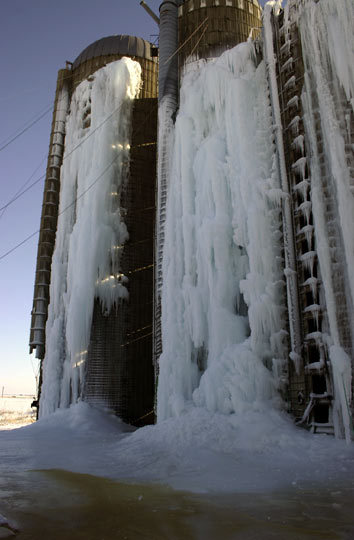
Four silos on the farm allows each to be iced in a slightly different fashion to accommodate different skill levels. [Photo] Andy Rowland
The Wisconsonian Glaciation, the last major glacial event on this continent, receded about ten thousand years ago, planing most of the region into a featureless expanse of slightly rolling hills. The repercussions of that geologic event have wreaked havoc on the psyches of Midwestern climbers ever since. From desperate rock junkies traversing the walls of the Fargo, North Dakota YMCA, to questionably sane fourteen-year-old boys stealing their older brother’s ice tools and dry-tooling road cuts in Black Earth, Wisconsin, the vertically minded in the Midwest, as seen in the first of this series of Weekly Features, will go to desperate measures to get their climbing fix. In this third installment, a climber and his friends accidentally become addicted. The results are ice-encrusted silos, expressions of the collective power of committed climbers.
Unlike most of us, whose first steps into the world of climbing often involved dusty vehicles and dusty characters with interesting perspectives on employment and personal hygiene, Don Briggs was paid to learn the sport. He was paid–in actual US currency, not free pints nor pairs of shoes–as the Instructor of Outdoor Pursuits at Northern Iowa University in Cedar Falls, Iowa. Twenty years ago, when the head of the department was brainstorming ways to make their offerings more comprehensive and complete, the idea of rock climbing arose. No one in the department knew how to do it, so Don volunteered to be trained in the sport. Now, twenty years later, the college has a 3,000-square-foot climbing facility, and Don is an avid climber.
After several trips to Colorado hooked him on ice climbing, Briggs often found himself driving hours, knowing forecasts uncertain, to the nearest natural ice in Wisconsin or Illinois. He’d find questionable conditions and hordes of people crowding a limited number of climbs. This most certainly would not do.
Driving around on a tractor in his friend’s fields one day, Briggs noticed, for the thousandth time, the 70-foot silos that dot every flatland farm. He’d often thought about climbing them, as anything with vertical relief, natural or not, makes all Midwestern climbers salivate. This time, though, a different thought crossed his mind.
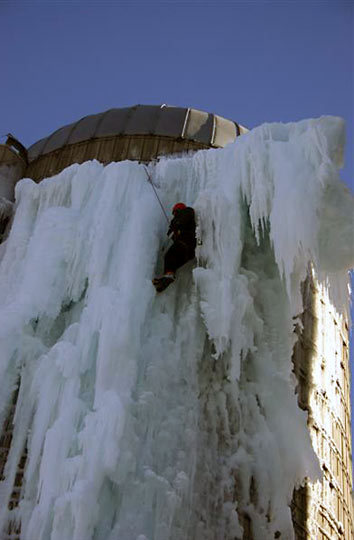
Don Briggs, encountering some difficulties at the wildly featured top of the silo. [Photo] Andy Rowland
“Hey Jim, how would you feel about icing those things up and letting us climb on them?”
“Sure.”
A year of trial and error led them to perfect their icing methods on one of the farm’s four silos. Frozen hoses, wind-blocking tarps, smooth and vertical climbs inaccessible to beginners and lengthy spring clean-up all confirmed that icing a silo was a lot more work than it seemed. But Briggs and his silo-owning friend, Jim Budlong, gave it another go the following year.
During the second season the University supported two different ice-climbing classes and a small competition, “with ten to fifteen locals for fun,” Briggs said. “The [Cedar Rapids] Gazette covered the story, Red Bull heard about it, called me up, and offered to sponsor the event.”
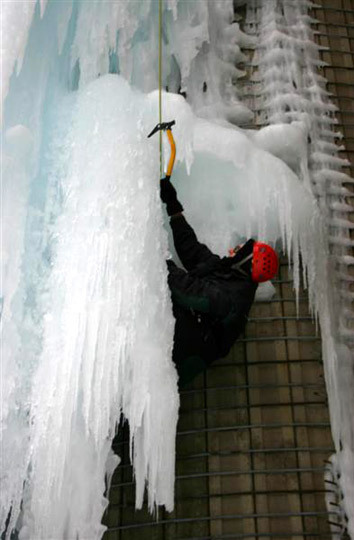
Don Briggs surmounting yet another overhang on the “difficult” silo. [Photo] Andy Rowland
The resulting speed-climbing competition–drawing climbers from as far away as Saskatchewan–was a Red Bull event for the next three seasons. The fourth season, Backcountry.com, among others, donated gear for educational use and as prizes for the competition.
Don described his vision of ice creation in a book, Silo Ice Climbing: Ice Climbing in the Midwest, an instruction manual that describes the intricacies of the project. It includes logistical information, such as legal protection for the climbers and owners, that allow would-be ice farmers to focus on the climbing and not the potential repercussions.
In conversation, Don is calm, self-effacing to a certain degree, and quietly adamant about his principles. He pays for a portable toilet on site to head off issues with sanitation, and he sets up strict rules regarding foul language and smoking.
“Can’t have people smoking, certainly not smokin’ the wrong tobacco; it puts off the wrong message.”
Good luck, as the general weekend mix on a non-comp weekend is half Northern Iowa students and half members of the local climbing community.
The numbers quickly grew. “Think you’re the only ice climber in your area? Guess again. The word will quickly get out, as it’s pretty tough to hide a silo draped with a ton (or ten) of ice. You’ll be surprised how the word will spread, and ice climbers are going to come creeping out of the woodwork… and will no doubt obtain your phone number to call you to see if you would be willing to share your ice.”
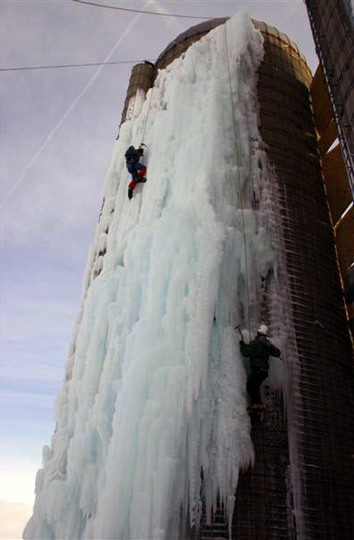
The structure of the silo allows for easy attachment of multiple anchors. [Photo] Andy Rowland
Think you and your friends are the only ones who can ice climb? “Get the farmer and his family on the ice, and they’ll be doing the setup the following year and offering ways to make it even better. They will be more receptive to the whole process.
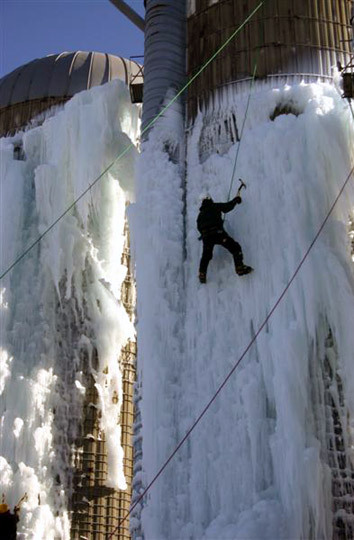
Unknown climber. Farming ice on the north side of the silo is crucial to keeping the season, such as it is, as long as possible. [Photo] Andy Rowland
“We’re all guests here at the place. If we go out to dinner, we take the farmer with us, pay his tab. We pitch in on jobs around the farm. If Jim needs to move some hogs and asks for two people to help, we send four. If he asks for four, we send eight.”
Last year’s late-season ice collapse left the farmer’s grain bin destroyed, and Don’s bank account equally devastated. He paid for the replacement out of pocket, and, instead of giving up, is hoping that his experience with liability waivers and the legal recreational use of private lands will help him to open a local quarry to farmed ice. He’s been eyeing it for the last few years, and if he can get local authorities’ support, Iowa may have some taller, and slightly less bizarre-looking, ice this season.